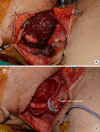Recipient vessel selection for head and neck reconstruction: A 30-year experience in a single institution
- PMID: 33143393
- PMCID: PMC7644354
- DOI: 10.7181/acfs.2020.00339
Recipient vessel selection for head and neck reconstruction: A 30-year experience in a single institution
Abstract
Background: The advance in microsurgical technique has facilitated a proper approach for reconstruction of extensive head and neck defects. For the success of free tissue reconstruction, selection of the recipient vessel is one of the most important factors. However, the vascular anatomy of this region is very complex, and a clear guideline about this subject is still lacking. In this study, we present our 30 years of experiences of free tissue reconstruction for head and neck defects.
Methods: In this retrospective study, we analyzed a total of 138 flaps in 127 patients who underwent head and neck reconstruction using free tissue transfer following tumor resection between October 1986 to August 2019. Patients who underwent facial palsy reconstruction were excluded. Medical records including patient's demographics, detailed operation notes, follow-up records, and photographs were collected and analyzed.
Results: Among a total of 127 patients, 10 patients underwent a secondary operation due to cancer recurrence. The most commonly used type of flap was radial forearm flap (n= 107), followed by the anterolateral thigh flap (n= 18) and fibula flap (n= 10). With regard to recipient vessels, superior thyroid artery was most commonly used in arterial anastomosis (58.7%), and internal jugular vein (51.3%) was the first choice for venous anastomosis. The flap survival rate was 100%. Four cases of venous thrombosis were resolved with thrombectomy and re-anastomosis.
Conclusion: Superior thyroid artery and internal jugular vein were reliable choices as recipient vessels. Proper recipient vessel selection could improve the result of head and neck reconstruction.
Keywords: Free tissue flap; Head and neck cancer; Microsurgery; Neck dissection.
Conflict of interest statement
No potential conflict of interest relevant to this article was reported.
Figures


Similar articles
-
Does the Anastomosis Recipient Vessel Have an Influence on Free Flap Perfusion in Microvascular Head and Neck Reconstruction-A Retrospective Analysis of 338 Cases with Comparison of Flap Perfusion between Different Arterial and Venous Recipient Vessels in Radial Free Forearm Flaps, Anterolateral Thigh Flaps, and Fibula Free Flaps.J Clin Med. 2024 May 8;13(10):2763. doi: 10.3390/jcm13102763. J Clin Med. 2024. PMID: 38792305 Free PMC article.
-
Selection of recipient vessels in double free-flap reconstruction of composite head and neck defects.Plast Reconstr Surg. 2005 May;115(6):1553-61. doi: 10.1097/01.prs.0000160274.21680.6f. Plast Reconstr Surg. 2005. PMID: 15861058
-
Recipient Vessel Selection in Head and Neck Reconstruction Based on the Type of Neck Dissection.Yonago Acta Med. 2016 Jun 29;59(2):159-62. eCollection 2016 Jun. Yonago Acta Med. 2016. PMID: 27493487 Free PMC article.
-
Free flaps for head and neck cancer reconstruction: Does the use of both large cervical vessels as recipient vessels and the employment of end-to-side technique enhance flap survival?Can J Plast Surg. 2003 Fall;11(3):141-2. doi: 10.1177/229255030301100307. Can J Plast Surg. 2003. PMID: 24115856 Free PMC article. Review.
-
Microsurgical workhorse flaps in head and neck reconstruction.Clin Plast Surg. 2005 Jul;32(3):421-30, vii. doi: 10.1016/j.cps.2005.02.006. Clin Plast Surg. 2005. PMID: 15979480 Review.
Cited by
-
Ultrasound in Microsurgery: Current Applications and New Frontiers.J Clin Med. 2024 Jun 11;13(12):3412. doi: 10.3390/jcm13123412. J Clin Med. 2024. PMID: 38929941 Free PMC article. Review.
-
Usefulness of perforating branches of the deep femoral artery and vein as recipient vessels during free-flap reconstruction for extensive defects of the thigh.J Surg Case Rep. 2023 Dec 28;2023(12):rjad683. doi: 10.1093/jscr/rjad683. eCollection 2023 Dec. J Surg Case Rep. 2023. PMID: 38163057 Free PMC article.
-
The Multidisciplinary Team in Head and Neck Cancer Reconstruction: A Reference Manual for the Plastic Surgeon.Semin Plast Surg. 2025 May 21;39(2):103-112. doi: 10.1055/s-0045-1808273. eCollection 2025 May. Semin Plast Surg. 2025. PMID: 40406636 Review.
-
Anatomical Study of the Application of a Galeo-Pericranial Flap in Oral Cavity Defects Reconstruction.J Clin Med. 2023 Dec 6;12(24):7533. doi: 10.3390/jcm12247533. J Clin Med. 2023. PMID: 38137603 Free PMC article.
-
The Journey of the Lingual Artery from the Neck to the Oral Cavity: A Cadaveric Study.Craniomaxillofac Trauma Reconstr. 2022 Mar;15(1):39-45. doi: 10.1177/19433875211002058. Epub 2021 Mar 16. Craniomaxillofac Trauma Reconstr. 2022. PMID: 35265276 Free PMC article.
References
-
- Ferlay J, Shin HR, Bray F, Forman D, Mathers C, Parkin DM. Estimates of worldwide burden of cancer in 2008: GLOBOCAN 2008. Int J Cancer. 2010;127:2893–917. - PubMed
-
- Serletti JM, Higgins JP, Moran S, Orlando GS. Factors affecting outcome in free-tissue transfer in the elderly. Plast Reconstr Surg. 2000;106:66–70. - PubMed
-
- Colen LB, Stevenson A, Sidorov V, Potparic Z, Pacelli E, Searles J, et al. Microvascular anastomotic thrombosis in experimental diabetes mellitus. Plast Reconstr Surg. 1997;99:156–62. - PubMed
-
- Bengtson BP, Schusterman MA, Baldwin BJ, Miller MJ, Reece GP, Kroll SS, et al. Influence of prior radiotherapy on the development of postoperative complications and success of free tissue transfers in head and neck cancer reconstruction. Am J Surg. 1993;166:326–30. - PubMed
LinkOut - more resources
Full Text Sources

